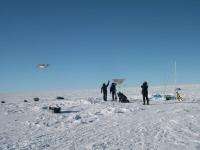Research icebreaker ‘Polarstern’ drifting in Antarctic ice

Since November 27, an ice floe has served as home as well as working place for 55 scientists from 11 nations. The research icebreaker ‘Polarstern’ of the Alfred Wegener Institute for Polar and Marine Research in Bremerhaven has been tied up firmly to a drifting ice floe in the Antarctic Weddel Sea.
As part of the expedition ‘Ispol’ (Ice Station POLarstern), the floe is the object of a several week investigation by glaciologists, biologists, oceanographers and meteorologists. The area of investigation represents a unique ocean region, because it has the largest percentage of perennial sea ice in the Southern Ocean. The oceanographic, meteorological and biological processes in this region are of global significance.
The floe
Floe dimensions are roughly four by four kilometres. It consists of numerous impressive pack-ice ridges, as well as several planes with approximately half metre snow cover. The ice layer below is between one and more than two metres thick. On the ice floe, ‘streets’ have been flagged to be used by commuting skidoos supplying the various working sites with equipment and personnel. At the beginning of the investigations, the floe was located at 68ºS/55°W in a region previously avoided by all ships because the thickest sea ice of the Antarctic is found here. Dr Gerhard Dieckmann of the Alfred Wegener Institute, one of the ‘Ispol’ initiators, expresses his relief: “Arrived! Finally – after four years of preparation!”
Research on the floe
Currently, numerous research activities are carried out on the floe under the direction of expedition leader Prof Dr Michael Spindler of the ‘Institute of Polar Ecology’ at Kiel University. Meteorologists record the effects of weather on ice properties. Glaciologists and biologists study the structural changes of the ice and the impact of the starting austral summer on highly productive small organisms living in the ice, such as single celled algae and plankton animals.
A group of bio-geochemists studies gas fluxes relevant to climate that are either produced by ice algae, or are exchanged to and from the atmosphere through the ice. The scientific diving team of the Alfred Wegener Institute provides valuable services for investigation of the ice underside, for instance by installing nets for catching plankton organisms living in this environment.
Positioned on ‘Polarstern’, researchers take samples from great water depths which, apart from collecting organisms, also provide information on trace gases, and temperature and salinity distributions. Scientists use the helicopters aboard, among other things, for deployment of buoys measuring the drift of floe fields surrounding the drift station. In addition, ice thickness is measured with a specialised sensor, the ‘Bird’. Scientists will likely sample the ice floe continually until January 5, 2005.
On the ‘Ispol’ website http: //www.ispol.de, the ‘Ispol’ expedition can be followed through a detailed expedition log, and images from the site provide an impression of the work on the ice.
‘Polarstern’ is expected back in Bremerhaven on June 17.
Source: Alfred Wegener Institut für Polar und Meeresforschung















